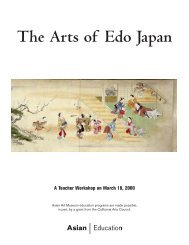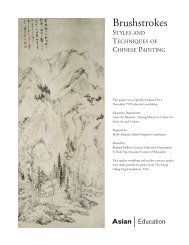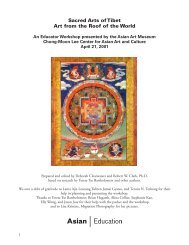China:The Glorious Tang And Song Dynasties - Asian Art Museum ...
China:The Glorious Tang And Song Dynasties - Asian Art Museum ...
China:The Glorious Tang And Song Dynasties - Asian Art Museum ...
You also want an ePaper? Increase the reach of your titles
YUMPU automatically turns print PDFs into web optimized ePapers that Google loves.
Chinese inner vision and view of the world and cosmos in a way that more abstract scholarly works<br />
did not; these creative works express what might otherwise remain theoretical or ethereal into palpable,<br />
understandable, and immediate terms.<br />
<strong>The</strong> most magnificent urban center in the world at the time, the capital of <strong>Tang</strong> <strong>China</strong>,<br />
Chang’an (literally “Everlasting Peace”), was a walled city built in alignment with the stars to symbolize<br />
its role as the world in miniature. <strong>The</strong> city witnessed the most splendid cultural achievements<br />
during the eighth century. As home to the most accomplished artists and thinkers of the day, it<br />
played much the same role as Florence did in fifteenth-century Europe. Just as it was witness to the<br />
height of <strong>Tang</strong> culture in the eighth century, it also was destined to be the focal point of the<br />
dynasty’s decline: when a rogue general decided to rebel in 756, not only was the emperor sent temporarily<br />
into exile, but the artists, poets, and priests of the city also fled. Although the political<br />
structure of the <strong>Tang</strong> remained in place for another 150 years (until 907), the city and state, with<br />
resources scattered, were weakened. Pretenders to the throne began to emerge, warlords began to<br />
consolidate authority, and nomadic peoples on the northern and western borders of the country also<br />
competed for political power. But it was a gentle decline: overall the three hundred years of the <strong>Tang</strong><br />
were marked by impressive advances in all aspects of art, science, and philosophy.<br />
By the early tenth century, the <strong>Tang</strong> ruling house fell, and a period of chaos ensued. <strong>China</strong> was<br />
divided into at least fifteen different independent political regimes, and peoples on the border areas<br />
set up their own states. <strong>The</strong> cultural glory of <strong>Tang</strong> was eclipsed, surviving only among tiny warring<br />
states. However in the year 960, another unified empire arose, the <strong>Song</strong>.<br />
<strong>The</strong> <strong>Song</strong> dynasty was the second great "medieval" period of <strong>China</strong>. But unlike the <strong>Tang</strong>, it<br />
coexisted uneasily with powerful rivals to the north. <strong>The</strong>se rivals were the Khitan Tartars of<br />
Manchuria and Mongolia, kept at bay only through costly bribes, and the Jurchen people of Central<br />
Asia, who were intent on conquering <strong>China</strong> but could not be influenced by payoffs. While the <strong>Song</strong><br />
dynasty managed to recapture—and develop—much of the glory of the <strong>Tang</strong>, it did suffer a blow in<br />
1127 when the Jurchen took the capital of Kaifeng, and sent the <strong>Song</strong> Chinese administration<br />
southward, to establish the Southern <strong>Song</strong> capital at Hangzhou, near modern Shanghai. Still the<br />
Northern <strong>Song</strong> (while it lasted) and the Southern <strong>Song</strong> (from 1127 until 1279) achieved incredible<br />
feats of learning, science, art, and philosophy. To the Chinese, the <strong>Song</strong> was a period certainly as<br />
great as the <strong>Tang</strong>. International trade and exchange of ideas continued to flourish, although (during<br />
the later <strong>Song</strong>) primarily through expanding networks of southern sea ports and ocean-going<br />
argosies.<br />
<strong>Song</strong> intellectuals reacted to the threatened existence of their dynasty by developing a defensive,<br />
inward-looking strategy: a belief that the Chinese and only the Chinese were capable of true greatness.<br />
Some closed their minds to the world outside <strong>China</strong> and set about the task of defining<br />
Chinese canons of proper behavior, government, and arts. Most Buddhist doctrines (judged to be<br />
non-Chinese) were largely purged during the <strong>Song</strong>, and the native Chinese philosophies of<br />
Confucianism (in particular) and Daoism saw a resurgence. In fact the great philosopher Zhu Xi<br />
taught hopeful students a new and “purer” version of Confucianism that came to be called “Neo-<br />
Confucianism.” This philosophy tried to recapture the Confucianism of the past, while integrating<br />
other philosophical ideas that had since come into existence. Neo-Confucianism taught people<br />
proper Chinese views of the cosmos and of behavior, and provided answers for other “big questions”<br />
5
















